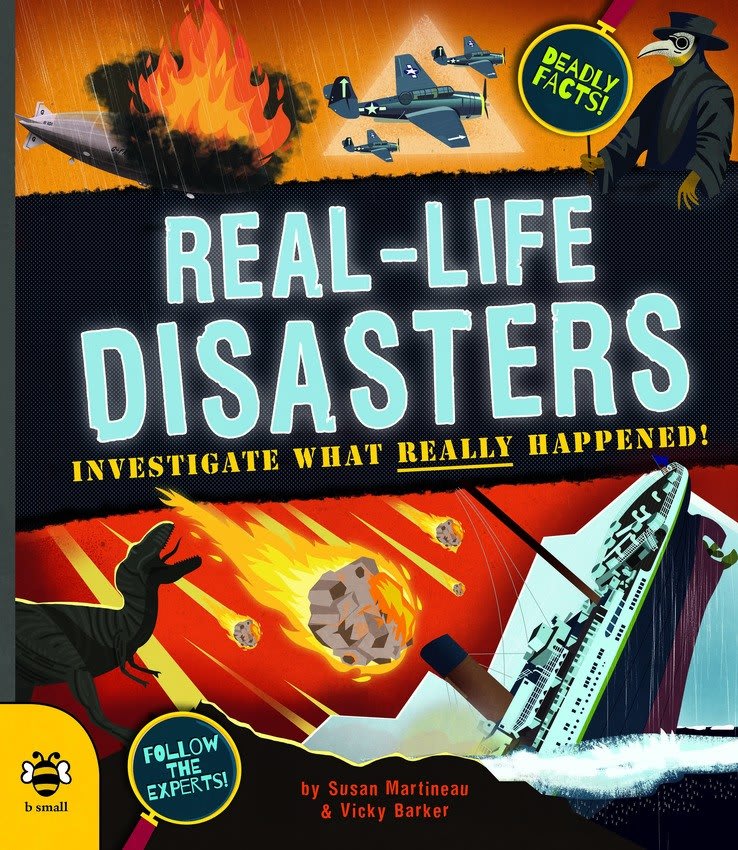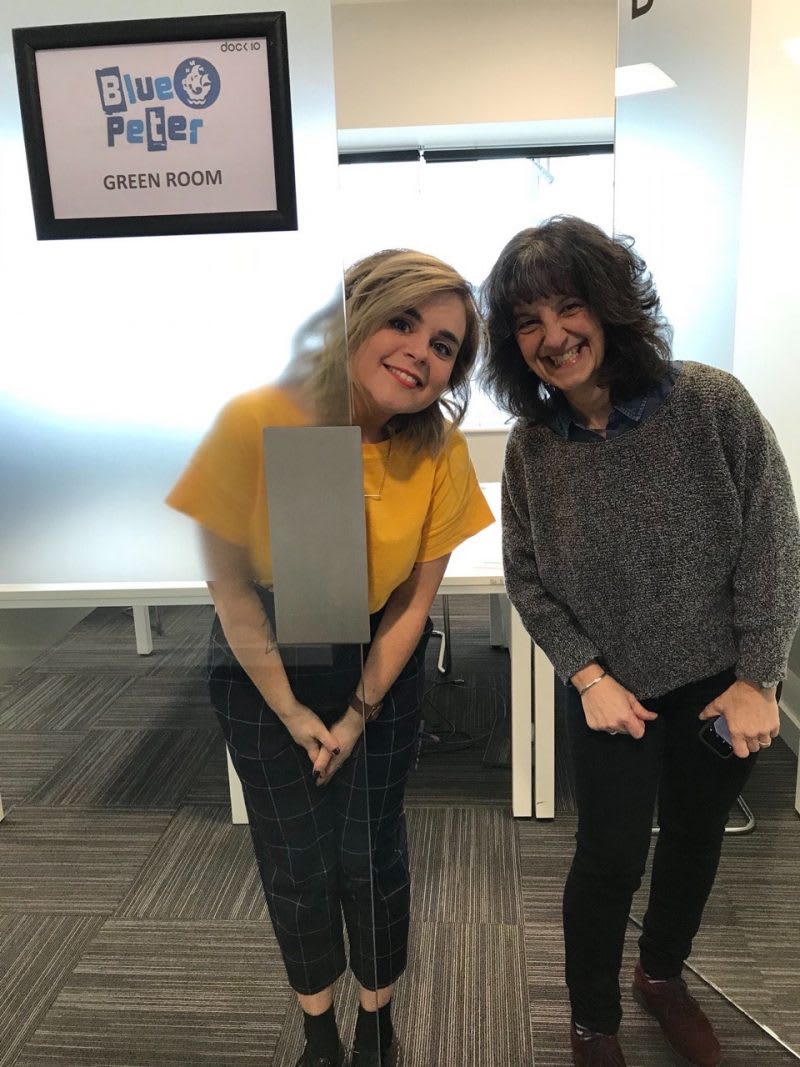Real-Life Mysteries – Q&A With Award-Winning Children’s Book Creators

One of the most important skills that any historian needs to have is the ability to question things, and to think critically about the information that they have in front of them. Misinformation about current and historical events can be found everywhere so it’s never too soon for children to learn how to distinguish the ‘fake news’ from the facts.
Author Susan Martineau and illustrator Vicky Barker created their book Real-Life Mysteries as a fun and fascinating way for children to learn these critical literacy skills. That brilliant book went on the win the Blue Peter Book Award 2018 – Best Book With Facts. Their follow-up, Real-Life Disasters, was released at the beginning of this month and I was very lucky to be able to ask Susan and Vicky some questions about what inspired them when they were writing and illustrating their brand-new book.
Q. Real-life Disasters is the follow up to your Blue Peter Book Award winning Real-life Mysteries. What made you want to move from investigating mysteries to examining disastrous events?
Susan: Disasters, like mysteries, can be really scary for children (myself included!). It seemed like a very good idea to investigate some disasters and create ‘dossiers’ for each of them, like the ‘case files’ in Real-life Mysteries. These ‘dossiers’ explain the facts behind each disaster and all the amazing experts who work on investigating and, hopefully, preventing such disasters from happening in the future.
Q. Susan, how did you choose which disasters to include?
Susan: It was really difficult! I read a ridiculous amount of information about disasters throughout history. I decided we should have a good balance of man-made and natural disasters and make sure that we included disasters from all over the world, including some lesser-known ones that I haven’t seen in any other children’s books.
Q. In your research did you find any particular disasters which you were unable to include, or that you wish you’d been able to find out more about?
Susan: I spoke to some local schoolchildren and they were pretty clear that it would not be a good idea to include very recent disasters, like 9/11 for example, as it might be too upsetting for many people.
Q. Vicky, illustrations are just as important as text for conveying information. What research processes and references did you use when you were beginning to depict these disasters visually?
Vicky: This book, like Mysteries is absolutely packed with information! So it was important to research and collect the very best reference pictures to make the spreads work. The dossier idea allowed us to display the text in clear sections to cover all areas of the investigations, which was great as we had a nice template to work with! Susan provided me with great starting references from books, online articles, newspaper reports etc and I did further image research to get a variety of angles and content for certain scenes so we could include everything we wanted on the main spreads. The older the disasters, the trickier it was to find a lot of material to work with (no iPhones back then!) so we worked with black and white photos and paintings or drawings captured by local artists at the time. Was also really interesting sourcing the right looking fonts for the old newspaper articles!
Q. And what sources did you (both) find most informative or most misleading?
Susan: Well, I could write an essay on sources and getting lost on the internet! I looked at everything from eyewitness statements and newspaper reports to scientific articles and the official investigative reports about the particular disaster I was researching. Sometimes these threw up even more things to research as not all of experts necessarily agreed on what had happened. I tried to include a balance of expert views in that case.
Vicky: The internet was really helpful in most cases when looking for extra visuals, but as Susan said, it’s really easy to get lost down that path and it often opens up more doors than you wanted! It’s important to take the time and research carefully to get the correct information. If I wasn’t sure on something, I’d often ask Susan what she thought.

Q. Is there an event from Real-Life Disasters that you feel particularly drawn to and why?
Susan: The story of the Halifax Explosion of 1917 that destroyed the city resonates especially for me. I had a wonderful trip to Nova Scotia a few years ago. Halifax is the most friendly and amazing city and I was shocked to learn about this terrible tragedy in its history. People still talked about it, and were so proud that their city had been rebuilt from the ruins. Before I went there, I had never even heard of this disaster.
Vicky: There were a few disasters that I wasn’t familiar with at all, so while it’s often sad to read about these parts of our history, I find it all really interesting. As an illustrator, I have to say it was a challenge to capture certain scenes but I’m pleased that I managed to draw something quite technical like Titanic! Little Easter egg for you – in my version Jack and Rose both survive on that door – see if you can spot them! (Perhaps only people over the age of 30 will get this reference HAHA!).
Q. You’ve brilliantly presented your accounts of each of these disasters with a dossier of information relating to each event. This encourages your readers develop the critical literacy skills they need to question what they see and to make up their own minds about the past. Why do you think that this is important?
Susan: The critical literacy skills of asking questions, reading and checking facts, and thinking for yourself have never been more important. Young readers need to practise these skills to find out the true facts behind whatever they are reading or viewing, whether it’s about the past or present. The more they practise these skills the better they will become at detecting fact from fake.
Q. What would you say to parents who are worried about the amount of misleading information that their children are exposed to on television or social media?
Susan: Keep talking to them about what they are reading and viewing. Listen to their concerns and calmly practise those fact-detecting skills. Your children can become resourceful and resilient readers who will be able to defuse the news and really enjoy finding out the facts about our amazing world.
Q. Do you think that there is ever a case for embracing the fictional side of an account so long as it is clear that it is exactly that?
Susan: Yes! There are some really brilliantly researched books which can complement the more factual accounts. These fictional treatments can really bring an event to life and spura reader on to find out more.
Vicky: Also makes for some great TV and films!
Q. And, finally, how do you think your two ‘Real-Life’ books complement each other?
Susan: Apart from mysteries and disasters both being utterly fascinating, the books are connected by our ‘case file/dossier’ approach. We want to give the power back to the readers who can examine the facts and theories, and even do some more research of their own, using these as a kind of critical literacy template.
Thank you both so much for your brilliant answers and congratulations on your new book!
Thanks so much for asking us!
Both Real-Life Disasters and Real-Life Mysteries are available from all good book stockists and from bsmall.co.uk